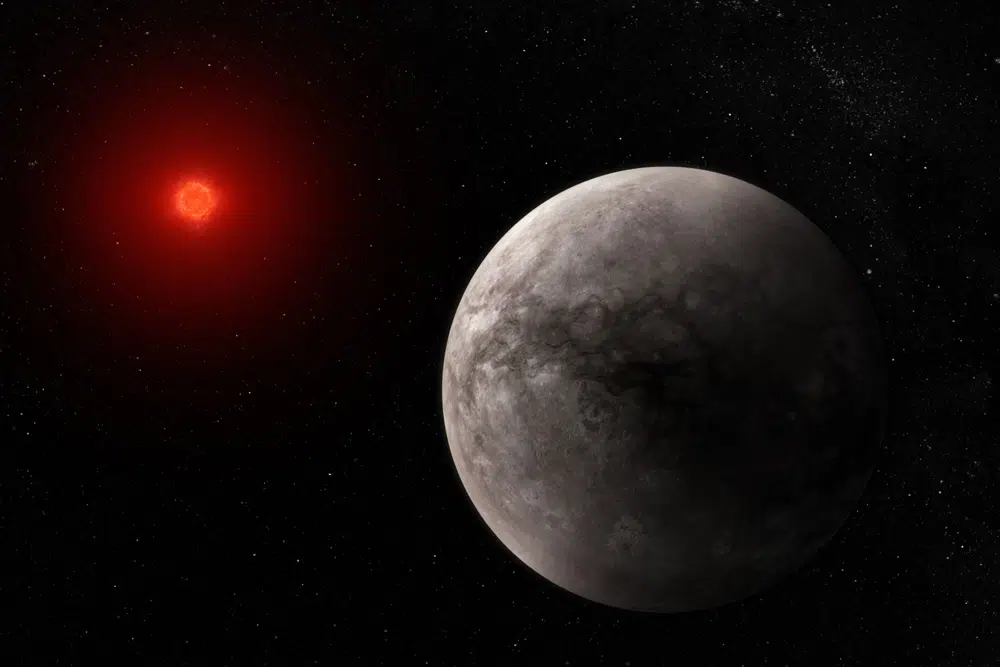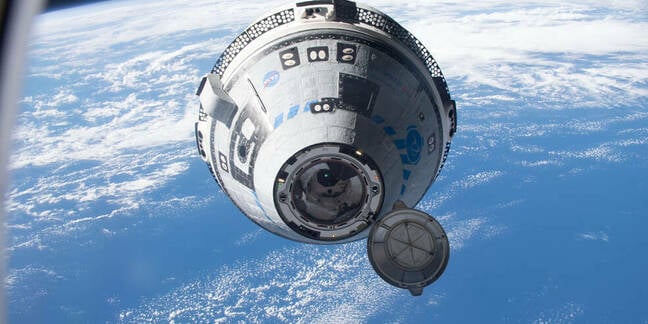Science
Webb Space Telescope Found No Evidence Of An Atmosphere At 7th Earth-sized Planet

(CTN NEWS) – According to recent findings by the Webb Space Telescope, there appears to be a lack of atmospheric presence on one of the seven Earth-sized, rocky planets orbiting a distant star.
Webb Space Telescope said that doesn’t bode well for the rest of this solar system’s planets
On Monday, a group of scientists at Webb Space Telescope Found No Evidence Of An Atmosphere At 7th Earth-sized Planet conveyed that this development is not a positive sign for the other planets within our solar system.
This is particularly concerning for planets in the optimal range for containing water and potentially supporting life.
According to Sara Seager, an astrophysicist from the Massachusetts Institute of Technology who was not involved in the research, it is not necessarily a failure for the other planets. However, it remains to be seen.
The Trappist solar system, comprising seven planets similar to ours, has piqued astronomers’ interest since its discovery at a distance of merely 40 light-years.
In the realm of cosmology, the aforementioned distance can be considered relatively proximate; to be precise, a light-year encompasses approximately 5.8 trillion miles.

Three of the seven planets are in their star’s habitable zone, making this star system even more alluring
This particular star system boasts a remarkable feature, as three out of its seven planets have been found to orbit within the habitable zone.
This intriguing discovery adds to the allure of the system and its potential for further exploration and study.
According to the findings of the team led by NASA, it has been reported that there is a negligible presence of atmosphere at the planet’s innermost region.
The findings were officially released on Monday via the esteemed scientific publication, Nature.
According to Thomas Greene, the lead researcher at NASA’s Ames Research Center, the absence of an atmosphere would result in the absence of water and inadequate shielding from cosmic rays.
Regarding the remaining planets revolving around the diminutive and faint Trappist star, Greene expressed his reservations about their atmospheric composition.
He conveyed his opinion via email, stating that he would have been more sanguine about the presence of atmospheres in the other planets if the current one had one.
According to Seager, a researcher at MIT, in the event that the rocky planets revolving around ultracool red dwarf stars fail to meet expectations, the search for Earth-like planets around sun-like stars may be a protracted undertaking.
According to Greene, the absence of an atmosphere in the innermost planet of the Trappist system could be attributed to the intense solar radiation it receives, which is four times greater than what Earth receives from its sun.

According to his team’s findings, the temperatures on the side of the planet constantly facing its star were recorded to be as high as 450 degrees Fahrenheit (230 degrees Celsius).
Utilizing Webb, the most extensive and potent telescope ever launched into space, American and French scientists successfully gauged the luminosity variation as the innermost planet transited behind its star.
This enabled them to approximate the quantity of infrared radiation emitted by the planet.
The European Space Agency has acknowledged the significance of Webb’s detection of the planet despite the minimal change in brightness due to the Trappist star’s luminosity being over 1,000 times greater than the planet’s.
This achievement marks a major milestone in the field.
Further observations are scheduled on the aforementioned planet and the other celestial bodies in the Trappist system.
Hubble was replaced by Webb in late 2021, 1 million miles (1.6 million kilometers) away
According to Taylor Bell, a member of the research team from the Bay Area Environmental Research Institute, it is possible that observing this planet through a different wavelength may reveal an atmosphere that is comparably less dense than our own.
However, the likelihood of such an atmosphere being sustainable remains uncertain.
According to Michael Gillon, a team member that identified the initial three Trappist planets in 2016, additional investigation may reveal the presence of an atmosphere, albeit one that differs from Earth’s.
He was not a participant in the mostrecent study.
According to Gillon, the study of rocky exoplanets is a relatively unexplored field, as current scientific knowledge is primarily derived from observations of the four rocky planets within our own solar system.
Webb, deployed to an observation post situated 1 million miles (1.6 million kilometers) away, debuted in late 2021.
It is widely regarded as the successor to the Hubble Space Telescope, which has been in orbit around Earth for over three decades.
Previously, the Trappist system was thoroughly examined for atmospheres by the Hubble and Spitzer Space Telescopes. However, conclusive outcomes were not obtained.
According to Julien de Wit, an expert from MIT who was not involved in the study, “the inner planets offer unique learning opportunities that differ from those presented by other planets.
This is just the beginning of our exploration, and much is to be discovered.”
RELATED CTN NEWS:
NASA is Training Four Humans to Live on Planet Mars this Summer
Augmented Reality vs Virtual Reality: What’s The Difference And Which Is Better?

Science
NASA Switches Off Instrument On Voyager 2 Spacecraft To Save Power

NEW YORK — To save power, NASA turned off another scientific equipment on its long-running Voyager 2 spacecraft.
NASA Switches Off Instrument On the Spacecraft To Save Power
The space agency announced on Tuesday that 2’s plasma science instrument, meant to study the movement of charged atoms, was turned off in late September to allow the spacecraft to continue exploring for as long as possible, which is estimated to be into the 2030s.
NASA turned off a suite of instruments on Voyager 2 and its twin, Voyager 1, after exploring the gas giant planets in the 1980s. Both are currently in interstellar space or the region between stars. The plasma instrument on Voyager 1 stopped working years ago and was finally shut off in 2007.
The remaining four instruments on 2 will continue to collect data on magnetic fields and particles. Its mission is to investigate the regions of space beyond the sun’s protective sphere.
NASA Switches Off Instrument On Voyager 2 Spacecraft To Save Power
It launched in 1977, is the only spacecraft to have visited Uranus and Neptune. It is now more than 12 billion miles (19.31 billion kilometers) from Earth. 1 is more than 15 billion miles (24.14 billion kilometers) beyond Earth.
SOURCE | AP
Science
Hurricane Kirk Could Cause Dangerous Surf Conditions Along The US East Coast

MIAMI — Hurricane Kirk’s waves could generate life-threatening surf and rip current conditions this weekend throughout the United States East Coast, as well as in Bermuda, the Greater Antilles, and the Bahamas, according to forecasters.
Kirk was a Category 3 hurricane in the middle Atlantic Ocean that might grow further but was predicted to stay away from land, according to the Miami-based National Hurricane Center on Thursday.
Hurricane Kirk Could Cause Dangerous Surf Conditions Along The US East Coast
Kirk-generated swells were forecast to reach parts of the Leeward Islands on Friday, Bermuda and the Greater Antilles on Saturday, and the East Coast and the Bahamas on Sunday, according to the center.
No coastal watches or warnings were in effect. The major storm was around 1,130 miles (1,820 kilometers) east of the Leeward Islands, with maximum sustained winds of 125 mph (205 km/h).
Meanwhile, Tropical Storm Leslie formed late Wednesday in the eastern Atlantic and is expected to strengthen into a hurricane in the following days, forecasters said. It was also not considered a threat to the land.
Hurricane Kirk Could Cause Dangerous Surf Conditions Along The US East Coast
The storm was about 540 miles (870 kilometers) southwest of Cabo Verde’s southernmost tip, with maximum sustained winds of 45 mph (75 kph), according to the center.
The storms raged in the Atlantic as rescuers in the United States Southeast sought for missing persons after Hurricane Helene struck last week, leaving a trail of death and devastation.
SOURCE | AP
Science
NASA Sends First Manned Starliner Spacecraft to Space Station

NASA has announced astronauts Butch Wilmore and Suni Williams are safely in orbit on the first crewed flight test of Boeing’s Starliner spacecraft heading for the International Space Station.
As part of NASA’s Boeing Crew Flight Test, the astronauts launched a ULA (United Launch Alliance) Atlas V rocket from Space Launch Complex-41 at Cape Canaveral Space Force Station in Florida at 10:52 a.m. EDT Wednesday for an end-to-end test of the Starliner system.
“Two brave NASA astronauts are well on their way to this historic first test flight of a brand-new spacecraft,” stated NASA Administrator Bill Nelson. “Boeing’s Starliner represents a new era of American exploration. Human spaceflight is a risky endeavor, but it is worth it. It is an exciting time for NASA, our commercial partners, and the future of space exploration. “Go Starliner, Butch, and Suni!”
The flight test is part of NASA’s Commercial Crew Program and will help validate the transportation system, launch pad, rocket, spacecraft, in-orbit operations capabilities, and return to Earth with astronauts aboard as the agency prepares to certify Starliner for rotational missions to the space station. Starliner has already completed two uncrewed orbital missions, including a test to and from the space station, as well as a pad abort demonstration.

Boeing Starliner Makes Orbit
“With Starliner’s launch, separation from the rocket, and arrival in orbit, Boeing’s Crew Flight Test is right on track,” said Mark Nappi, vice president and program manager for Boeing’s Commercial Crew Program. “Everyone is focused on giving Suni and Butch a safe, comfortable, ride and performing a successful test mission from start to finish.”
Boeing’s mission control center in Houston will supervise a sequence of autonomous spacecraft maneuvers while Starliner is in flight. NASA teams will supervise space station activities from the Mission Control Center at the agency’s Johnson Space Center in Houston.
“Flying crew on Starliner represents over a decade of work by the Commercial Crew Program and our partners at Boeing and ULA,” said Steve Stich, Commercial Crew Program Manager at NASA’s Johnson Space Center in Houston. “For many of us, this is a career-defining occasion, ushering in a new crew transportation capacity for our agency and our country. We will take it one step at a time, putting Starliner through its paces and remaining watchful until Butch and Suni safely land back on Earth at the end of this test journey.”
At about 12:15 p.m., Starliner will dock autonomously to the forward-facing port of the station’s Harmony module. Thursday, June 6, and will remain at the orbital laboratory for almost a week.
Wilmore and Williams will help ensure that the spacecraft is functioning properly by testing the environmental control system, the displays and control system, and moving the thrusters, among other things, during flight.
Wilmore and Williams will join the Expedition 71 crew, which includes NASA astronauts Michael Barratt, Matt Dominick, Tracy C. Dyson, and Jeanette Epps, as well as Roscosmos cosmonauts Nikolai Chub, Alexander Grebenkin, and Oleg Kononenko.
NASA’s arrival and in-flight event coverage is as follows (all times Eastern and subject to change depending on real-time operations):
NASA Television channels will continue to broadcast the Starliner’s mission.
Thursday, June 6
9:30 a.m. – Arrival coverage begins on NASA+, the NASA app, and YouTube, and continues on NASA Television and the agency’s website.
12:15 p.m. – Targeted docking
2 p.m. – Hatch opening
2:20 p.m. – Welcome remarks
3:30 p.m. – Post-docking news conference at NASA Johnson with the following participants:
- NASA Associate Administrator Jim Free
- Steve Stich, manager, NASA’s Commercial Crew Program
- Jeff Arend, manager for systems engineering and integration, NASA’s International Space Station Office
- Mark Nappi, vice president and program manager, Commercial Crew Program, Boeing
Coverage of the post-docking news conference will air live on NASA+, NASA Television, the NASA app, YouTube, and the agency’s website.
To attend the post-docking briefing, U.S. media must contact the NASA Johnson newsroom at: [email protected] or 281-483-5111 by 1 p.m. Thursday, June 6. To join by phone, media must contact the NASA Johnson newsroom by 3 p.m. Thursday, June 6.
5:50 p.m. – NASA Administrator Bill Nelson, Deputy Administrator Pam Melroy, Associate Administrator Jim Free, Associate Administrator for Space Operations Ken Bowersox, and Johnson Space Center Director Vanessa Wyche will speak with Wilmore and Williams about their launch aboard the Starliner spacecraft.
Coverage of the Earth to space call will air live on NASA+, NASA Television, the NASA app, YouTube, and the agency’s website.
Saturday, June 8
8:50 a.m. – NASA astronauts Wilmore and Williams will provide a tour of Starliner.
Coverage of the in-orbit event will stream live on NASA+, NASA Television, the NASA app, YouTube, and the agency’s website.
Monday, June 10
11 a.m. – Williams will speak to students from Sunita L. Williams Elementary School in Needham, Massachusetts, in an event aboard the space station.
Coverage of the Earth to space call will air live on NASA+, NASA Television, the NASA app, YouTube, and the agency’s website.
Tuesday, June 11
3:15 p.m. – Wilmore will speak to students from Tennessee Tech University in an event aboard the space station.
Coverage of the Earth to space call will air live on NASA+, NASA Television, the NASA app, YouTube, and the agency’s website.
-

 News3 years ago
News3 years agoLet’s Know About Ultra High Net Worth Individual
-
Entertainment2 years ago
Mabelle Prior: The Voice of Hope, Resilience, and Diversity Inspiring Generations
-

 Health4 years ago
Health4 years agoHow Much Ivermectin Should You Take?
-

 Tech2 years ago
Tech2 years agoTop Forex Brokers of 2023: Reviews and Analysis for Successful Trading
-

 Lifestyles3 years ago
Lifestyles3 years agoAries Soulmate Signs
-

 Movies2 years ago
Movies2 years agoWhat Should I Do If Disney Plus Keeps Logging Me Out of TV?
-

 Health3 years ago
Health3 years agoCan I Buy Ivermectin Without A Prescription in the USA?
-

 Learning3 years ago
Learning3 years agoVirtual Numbers: What Are They For?
